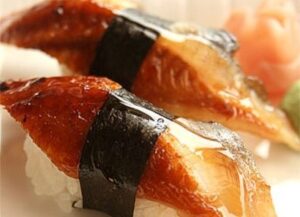Unagi & Anago (Eel Sushi)
Unagi & Anago – Eel Sushi

Unagi (freshwater eel) is known for its bold, rich taste, while anago (saltwater eel), is a more muted choice, known for its incredibly soft texture and natural sweetness. Both unagi and anago have played an important role in Japanese cuisine and culture for thousands of years, but the freshwater eel in particular has been making news as an at risk species.
Unagi is full of protein, vitamins and calcium, which may have influenced its role in the midsummer tradition of eating unagi on the Day of the Ox, in order to aid one’s strength and vitality for the coming year (though lovers of this dish will be found partaking year round). In addition to its strength giving properties, legend has it that unagi is a powerful aphrodisiac. If you are served unagi by someone versed in the lore, they may have other intentions than simply feeding you! And at home, be careful whom you serve it to! If you are serving unagi to someone familiar with the legends of increased virility, it could lead to a bit of a misunderstanding as Japanese women are known to serve the dish to their husbands when they wish to ignite the “flames of Roman passion.”
Nutritionally, unagi is quite high in protein, which could be how it got its reputation for virility and as an aphrodisiac. It is also loaded with vitamins and omega-3 fatty acids, and is truly an energy food.
Unagi is prepared through the same traditional methods that have been used for thousands of years and which bring out the bold, rich flavors of the dish. First the eel must be filleted and cleaned of all its tiny bones. It is grilled over an open flame which serves to melt off the layer of fat which lies under the skin. The eel is then steamed, drained of oil, and basted in a sweet eel sauce. Eel sauce is a mix of salty, sweet, and slightly savory and is different than many other sauces in that it will stick to your meal, rather than pooling at the bottom of a bowl The final and most important step is the second grilling, allowing the eel to absorb the flavors of the sauce.
Because Unagi has such strong flavor, it often served on a simple bed of rice (as unagi don) or as sashimi, though unagi maki (eel roll, often with avocado or cucumber) is popular in the West, and the simple nigiri-zushi style (simple eel sushi) has also become more common. Unagi sushi is called unakyu, and pairs the richness of Unagi with the refreshing crunch of cucumber. While it is common to see unagi in common serving styles, a classic way of serving freshwater eel is as sashimi. This allows the flavors to stand alone, and true eel lovers will often be see dining on eel in such a way.
Unagi is hugely popular in Japan, and has spread worldwide as a delicacy. It is most often enjoyed on hot summer days, with entire restaurants devoted to dishes of unagi. As worldwide popularity has risen, stocks of freshwater eel have crashed. This has lead to concerns of the stability of the industry. With wild stocks plummeting, producers of eel have switched to farming the product, with 90% of the eel currently sold in the US being farm raised, which occurs in numerous countries but Japan is keen on eel farming.
Farm raised eel unfortunately does not mean that the wild population are left untouched. The farming process is not done by spawning eels in captivity from eggs, but rather by collecting young eel from the wild before they have a chance to breed. There are also concerns that the open net pens used in the farming process allow disease, parasites, and farm waste products to flow from the pens to the surrounding wetland habitats of the eel. It is for these reasons that Seafood Watch, a sustainable seafood database, has recommended that consumers avoid the product.
Unlike its controversial freshwater cousin, anago is more well known for its sweetness and soft textures which melt in the mouth. Anago is often simmered for sushi or deep-fried for tempura. Anago are found in the Northwest Pacific, especially off the coasts of Japan where they make their homes in the sandy, muddy bottoms of the sea. They are frequently captured and then gown to adult size in Japan. While currently they do not have an at risk status, the industry is relatively new and untested.
Eel plays an important role in Japanese culture and cuisine, and is a delicacy in the heat of the summer. However, the ever-growing popularity of the dish has definitely lead to concern over its sustainability.
I have always been fascinated by the creation and culture of different foods, particularly sushi and sashimi in the modern era of Japanese cuisine. I am a classically trained chef and sushi connoisseur, also having operated a food service company and enjoy investigating and experimenting with food around the world.